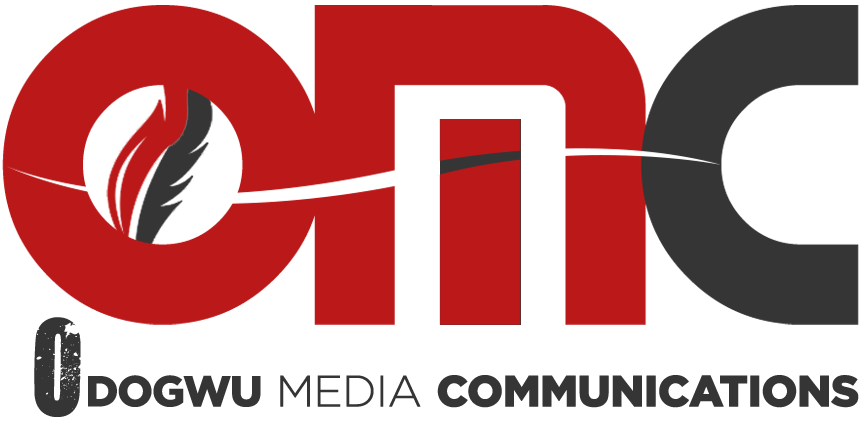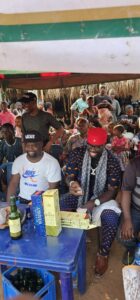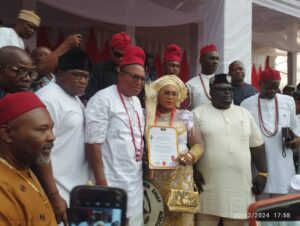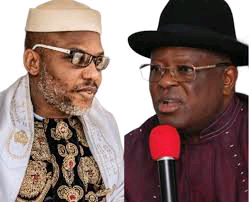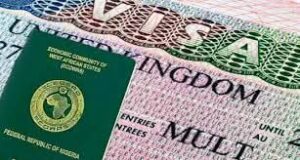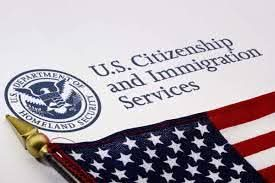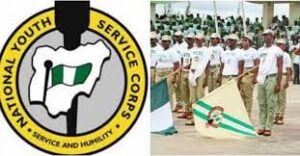The two main festivals in Urum Anike kingdom
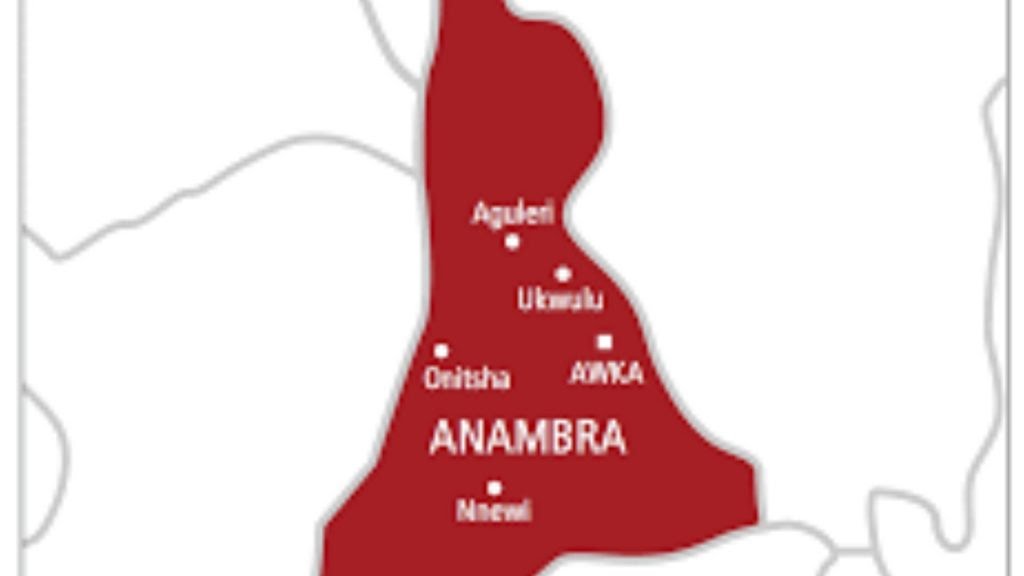
Festivals are annual or biannual gathering at which the whole community meets to honour and give thanks to God, the divinities and the ancestors. In Urum, each village has festivals which are peculiar to them, but the whole town has some common festivals which they celebrate together annually, which bound the people together socio-politically and religiously; and they include Egwu Ori Festival, Olili Opotor, Iri ji Ofuu or Oruru ji Onwa Isii/ Isaa among others.
Egwu Ori Festival
It is an agricultural festival and is held to mark the end of one agricultural year and to welcome the beginning of another. It is an occasion to honour and venerate Ori divinity and the ancestors (as intermediaries of God) for a successful agricultural year or farming season and to pray and hope for another glorious year. The yam or cassava is the most important agricultural product celebrated at this festive period. It is regarded as Ori’s birthday/month because of the manner in which the people of Urum celebrated. AS a result of this Nebolise Christian observed that:
Ori is the most potent and the most celebrated deity in Urum. Ori has its special festival called Egwu ori. The festival has remained a recurring decimal among Urum people in reawakening their cultural heritage and values. The festival takes place annually, before the commencement of the farming season. The festival remains a legacy which reveals the totality of our value system, norms and conventions which promote and bind our people together. The festival also marks the period of mass return, remain and a time to deliberate on matters affecting the town10.
From the above observation one discovers that Egwu-ori festival marks and duly represent the annual census system for the people of Urum; the period of stocktaking, funfair, merriment and thanksgiving in Urum.
Therefore, Egwu-ori festival begins with the sighting of the new moon which marks the display of masquerades, and especially the lion masquerades that parade in the night as the ancestors of the community. They send warning signals to people to put out their lights to avoid being attacked by the evil spirits. Before the date/days of the festival is fixed the oracle is either consulted to know the exact date or days in order to prevent the repeat of the celebration in a given year. In some cases the festival is fixed by the traditional priest and their assistants by their own reckoning to decide on the date.
According to Chief Ebenezar Nwakeze observed that, “The Chief Priest moderated in religious festivals, especially Egwu-Ori festival. Performed propitiatory rites and kept custody of the shrine.
Secondly, the outing of lion masquerades is expected to last three native weeks i.e. 12 days and Egwu-Ori festival lasts a native week. It is usually this period that puberty rites, for boys between the ages of 9 (nine) and 11 (eleven) are consummated which started during Aki Oyibo Onwaibo Festival when they engaged in Ikpu Ngada Mmanwu where they were trained on male roles in the community. It is known as Iba Mmanwu or Ima Mmuo, knowing the masquerades or spirit.
Thirdly, Iba Mmanwu is a way of enlisting the youngmen into the masquerade cult in Urum. In this context the spirits are ancestors and this is the initiation into the secret society of masked men. To the uninitiated, the masquerades are ancestors who have temporarily come back in visible form to participate in the affairs of the family of which they still are active members. On initiation day that is Eke Uchicha in Urum, Lion masquerades start very early on this day, and the patron of the age grade that would be enlisted with the help of the masquerades collect the prospective initiates from their homes and gather them at the village square, disappear with them in a secluded place or into the forest where their shrine is located. There, they are subjected to many hardships to teach them endurance, and are taught the secret codes of the mmuo society. Finally, they are shown that the masquerades or mmuo are, in fact, relations of theirs who have been wearing masks. Finally, they are placed under oath never to reveal the secrets of the rite. Meanwhile, the uninitiated are made to believe that at the shrine, the masquerades swallow them, and take them down to the spirit land where they learn the secret language and share the knowledge of the ancestors.
Fourthly, on the Orie or Oye day, the newly initiated members of the masquerade society with their new masquerades would awake the villagers from their sleep early in the morning with songs of bravery and victory, and the villagers would be happy to accept them for surviving the masquerade initiation. They would proceed to the village square where they will entertain the crowd that have gathered to receive them as brave young men. Later in the day, the people that took Ozo title that year would go to Orie or Oye market to display their affluence or riches where they will be received by other titled men in Urum. The arrival of the new titled men puts the town in a celebrative mood by dancing to the tunes of Ufie in the market to indicate their successful completion of title taking in Urum. On this day, people of Urum dress in their best apparels while going to the market to show solidarity to the new titled men.
Fifthly, some people would like to be present at the slaughtering of the sacrificial animal, usually ram at Ori which takes place early in the morning to mark the beginning of the whole ceremony. Thereafter, the priest will dress like a king and sit in his Obi where people would be paying homage to the divinity. In the 1950s, dances are organized in the evenings to round off the celebrations that last for four days in accordance with the customs and traditions of Urum. Through Egwu-Ori festival the people of Urum remember the ancestors and ask for their help and protection as well as abundance of food and health, and prosperity.
Finally, the climax of the festival is a public flogging competition and masquerading by the young men of the various villages in Urum which portray their manliness and sheer bravery. Each and every village takes part in the exercise in accordance with the order of their seniority in the community. This flogging competition usually takes three days to be completed by the villages. Egwu-Ori festival meant three important things to the community.
First is that it had great socio-political significance in the traditional life of the people as it instilled new lease of life to those who participated in the year’s annual event. As a result of which Festus Echetabu(chief priest of Ori Deity) said that every male adult in Urum participated in this festival to boost the male population of his village and to show his continual existence”11.
Secondly, it represented a traditional head count for the adult and marks the determination of the numerical strength of its male adult that determined the military might of the community.
Finally, the festival marked the community’s lunar annual calendar. Thus the eating of the last yam tuber signaled the end of the year for the town.
Olili Opoto: Cocoyam festival
This festival involves cooking and eating of cocoyam by all the married women in the community, usually it is done 12 days after the sighting of the New moon. It is a period of thanksgiving to God, divinities and ancestors by the womenfolk for successful harvesting of their coco yams. This ceremony is thus a remembrance of gods and the ancestors for giving them cocoyams and other farm crops, and assurance of hope for future planting of cocoyams. It is also an occasion for the renewal of fellowship between the living and the dead. It may also be used as a propitiatory ceremony for the ancestors where calamity had struck the town. The ceremony is also a social function as people rest from their labours and come together and fellowship, foods are shared and enjoyed when the youngmen collect the cocoyams from homes and eat together at the village square along with masquerades that symbolize the presence of the ancestors of the town, and in some cases disputes of all sorts are settled at this period. The ceremony is thus a cohesive factor of society.
Title-Taking-Ichi Ozo in Urum
The first stage of title taking in Urum, in the 1920s was Igbu-Ichi.
It signifies that the person is brave and courageous to take Ozo title in the community but today it is no longer regarded as necessary step in taking Ozo title in Urum.
The second stage is Ibu Amanwulu. At this stage, the person are expected to leave their houses and go to any of their relatives then they will stay there for eight days. During this period of seclusion, relation, friends, well-wishers and many others will pay homage to them. On the last day, they will wake up early in the morning and leave the places they were staying and go to the village square in company of their relations and well-wishers, then after the outing, they will return to their homes.
The third stage is Ogbagba-Ajuke. At this stage, the people are expected to cook food for their units of Nze na Ozo in Urum. It takes place in the fifth month Igbo Lunar calendar.
However, the following are the basic processes in title-taking in Urum. They are as follows:
Isi nri ekwu;
Isi nri nsualo;
Isi nri nwammadu;
Isi nri ogwu na Ogbe;
Isi nri Oba;
Isi nri ntubaji na oba;
Isi nri Isaile;
Igbu Ewu Emem and;
Odudu afia/Ahiaemem
The fourth stage is Idana-emem. At this stage, the prospective title holders are expected to kill a goat for their units and they should not engage in any farmwork of all sorts during this period of their initiation into nze na ozo society.
The final stage is opupu afia Ozo. At this stage, the people are expected to go to the Oye/Orie market in their dresses with their relations, friends and well-wishers. During this outing they are expected to come with a keg of palm wine to the market.
End Notes
Mbiti J. S. African religion and Philosophy (London, 1969) P. 130.
Nnoruka Nneoke Personal Communication (28th December, 2015).
The Constitution of Urum Development Union (including Bye Laws, Rules and Native Customs of Urum Community) (1989) p. 45-46.
Constitution of Urum Development Union Op.cit p. 46-50.
Ogbaje, C. The Impact of Christianity on the Igbo Religion and Culture (Onitsha, 1995) P. 23.
Mbiti J. S Op.cit P. 140.
Ifesieh, Emmanuel I. Religion at the Grassroots (Studies in Igbo Religion (Enugu, 1989) P. 180.
Echetabu Festus Personal Communication (12th January, 2016).
Metuh, Ikenga God and Man in African Religion (London, 1973) P. 177.
Nebolise, C. O. The History and Socio-cultural Values (Amawbia, 2010). P. 58.
Echetabu Festus Op.cit
The Advent of Christianity In Urum Anike kingdom
The 18th century enlightenment, evangelical and revival movements that swept through Europe were responsible for the advent of Christianity in Urum. The enlightenment as written by Dike, “originated, in part, with Christian and humanitarian groups, and in part with the American French revolution”18. These groups in accordance with Azubuike’s observation, “preached the brotherhood of men and all worked towards the same end, namely the abolition of the iniquitous traffic in humans”19. This revival movement brought about the liberation of many African slaves by the judgement delivered by Lord Mansfield in 1772. It gave rise to the formation of missionary societies, who took it upon themselves to evangelize the benighted nations of Africa which was regarded then as Dark Continent.
It was the ex-slaves from Sierra Leone that pioneered the evangelization of Nigeria and especially Igboland of which Urum is inclusive. This was however made possible by the successful exploration of the Lower Niger by the Landers Brothers, which encouraged the Europeans Christians Missionaries to introduce Christianity, legitimate commerce, modern farming and Western education to the interior people. Christianity in Igboland owes its existence to no other person than the Most Revd. Samuel Ajayi Crowther of the Anglican Church, and his team namely J. Schon, Dr. Baikie and J. C. Taylor who were mainly Igbo ex-slaves that brought the good news to Igbo nation. This was supported by Baur who remarked that “in the 1880s, Catholic Missionaries followed the Niger River into interior, where since 1857 Bishop Crowther with his Sierra Leonean counterparts had worked alone”20. This does not mean that they were the first to evangelize Nigeria, as there were before them failed attempts by the Portuguese Birch Freeman of the Methodist and Revd. Henry Townsend of the church missionary society was already working as missionaries in Yoruba areas of Badagry Lagos, Abeokuta and Iyaye prior to the arrival of Crowther and his team.
Though Onitsha was chosen as the centre for the spread of Christianity in Igboland at that time; Aboh and Osomali were thought to offer favourable prospects due to their early contact with the Europeans. Thus Azubuike stated that “the missionaries landed in Onitsha on 27th July, 1857 and was well received by Chief Akazua of Onitsha, his son Odili and the rest of the Onitsha people”21. This year is always remembered in the Anglican Calendar as the year that marked the beginning of the Christian missionary enterprise among the Igbo and other ethnic groups inhabiting the South Eastern part of Nigeria. The towns around Onitsha became proselytized before the end of the decade, spreading to the northern part of Igboland and covering areas like Obosi, Asaba, Osomali, Atani, Nsugbe, Ogidi, Ogbunike, Awka, Agulu, Awkuzu, Ukpo, Ukwulu and Urum between 1857 and 1918. The church missionary society of England was the first to be established followed by the Roman Catholic Mission and other Christian churches/ spiritual bodies later arrived in Urum and its environs.
In 1916, the church missionary society came to Urum and people of Urum began to accept the good news; some mysterious sicknesses and diseases were healed by the church. As a result of this, some of the neighbouring towns like Amanuke, Mgbakwu, Isu-Aniocha and Achalla were already eagerly awaiting for the arrival of C.M.S. in their towns. No wonder Onwudiofu R. S. observed that;
When the gospel came in 1916, some people in the community embraced it. The C.M.S. dominated Urum being the first church to come for propagation of Christian ideology. The man through which it came was Arinze Umenyiora from Irunwanza (now Iruokpala) Atitinyi Village, because of that the first church site was at Nweliede i.e. a piece of land at Akitinyi22.
Nevertheless, the advent of Christianity occasioned a few slight modifications in the religious beliefs and practices of Urum people vis-à-vis their cultures. When some of the people of Urum were converted to the Christian faith, it became difficult for them to adapt to the English ways of life. As a result of this, the early converts developed uncommon desire in the word of God in order to master the Christian teachings as well as the white man’s language. These early converts include the following persons Abraham Anyano, David Okeke, Mark Oraekie, James Igwebuike, Jacob Nnamdi, Peter Onwudiofu, Joshua Ozuah, Reuben Anyano, Job Igweagbaka, Nathan Anowia, Gabriel Nduka, Emmanuel Anaelokwu, Josiah Igweagbaka, Isaac Onyejaka, John Onwuka, Enemuo Nkechi, Michael Anadumaka, Mmaduka Mmamilo, Emmanuel Alokwu, Joseph Attado, Serah Anyano etc. These early converts showed marked fanaticism towards their new found faith, as they renounced their wives but one, destroyed their idols openly, desecrated sacred places which were signs of growing antipathy towards the traditional beliefs and practices, Onwudiofu submits that “the first church teacher was Mr. Gabriel Okpo from Nawfija 1916-1918”23. He went further to observe thus:
The second church teacher was Mr. Gabriel Amaechina from Umunze. Believers were always together sharing the word of God and praying as the apostles of the old, loving each other and exchanging visits. They attempted breaking some fetish ideas and practices highly held in the community. They also openly preach against idol worshipping. They go beyond the community to spread the gospel of Jesus Christ. As a result of this, they were seen as enemies who flout laws and customs of the community with impunity. They were seriously persecuted especially those who attack idols and their worshippers. Some lost their lives in the process and those living were called bad names and on the slightest misfortune they were ridiculed. Their misfortunes were associated to the wrought of one idol or the other which was purported to be angry with them. They did not mind all these but continued with the gospel which was so strange and lack the life style of the environment24.
As days went by, they began to win many converts especially the prominent people in the community. The church missionary society recorded a milestone in 1920 when they converted the then Chief Okafor Nweke (Igwe of Urum) at that time. As the converts increased, there arose a need for relocation of the church. Igwe Okafor Nweke suggested an evil forest situated at Ndiuno Ifiteora as an ideal venue. This was an evil forest where people that died bad deaths were thrown to be eaten by vultures. But when they built their church there and recorded no death. Then the people of the community began to embrace Christian faith with a renewed zeal and interest. Onwudiofu observed that “School was started which was an instrument of propagating Christianity. Children started going to school and they were taught catechism among other subjects”25.
In 1950, the Roman Catholic Church was the second Christian mission to arrive Urum as well as the church to be founded in Urum. The man through which it came was Chief Joshua Ozuah from Irunwanza (now Iruokpala) Akitinyi Village, Urum, who was one of the founding members of Anglican Church in Urum. They arrived at the time the church missionary society which had already been established in Urum were having some internal problems such as power tussle and certain stringent measures that were adopted by the church authority and for which some members backslidden and others left for new denominations. One of such measures was the Saturday manual labour imposed on the converts. The internal problems in the C.M.S. were capitalized upon by the Roman Catholic Mission, as a result of which their arrival provided an alternative denomination for the deserting members. The advent of the Roman Catholic Church should be credited to power tussle between Igwe Okafor Nweke and Chief Joshua Ozuah at that time.
The early Roman Catholic converts include Echetabu Tagbo, Ernest Oraekie, Okafor Mmadubuko, Oranwusi Chinwuko, Nwankwo Ejiaja, Jideuno Onuzulike and many others; and they can be referred to authoritatively as the founding members of the new found church in Urum. At that time, members of the church treated one another like brothers and sisters and shared what they had in common without discrimination in their choice of relationship.
In 1966, Christ Holy Church International Nigeria (AKA Nation builders- Odozi Obodo) arrived in Urum as an African Independent Church in Nigeria founded by late Mrs. Agnes Okoh in 1947. The founder of this church was called by God to be an itinerant evangelist in 1947.
In 1970, other Christian denominations began to be established in Urum and its environs at that time.
End Notes
Nebolise Christian O., the History and Socio-cultural Values (Amawbia, 2010) P.5.
Amechi Godson Onochie, Obosi in Perspective the past, present and future History and Culture of Obosi (Ikoyi, 2012) P. 2.
Amechi Godson Onochie, Op. cit. P. 2-3.
Nebolise Christian O., Op.cit. P.27.
Fidelis C. Idigo, Igbo History Hebrew Exiles of Eri Kingdom (Enugu, 2006) P. 21.
Fidelis C. Idigo, Op.cit P. 21.
Edmund Ilogu, Christianity and Igbo culture (Onitsha, 1985) P.1.
Adiele Afigbo, Ropes of Sand Studies in Igbo-History and Culture (Nsukka, 1981) p. 41.
Christopher O. T. Ugwu, Man and His Religion, in a Contemporary Society (Nsukka, 2002) P. 38.
Amechi Godson Onochie Op.cit P.5-6.
Nebolise Christian O. Op.cit P. 27.
Enoch P. Nmah, Women’s rights in Igboland: A Christian Reappraisal (Aba, 2003) P.25.
I. R. A. Ozigbo, Roman Catholicism in Southeastern Nigeria, 1985-1931: A study in Colonial Evangelism (Onitsha, 1988) P.26.
Emefiene I.R. The History of Ubulu people: With a special searchlight on Ubulu Unor (Benin, 2006) P. 163.
Nneoka Nnoruka, Personal Communication (13th Oct, 2015).
E. B. Idowu, African Traditional Religion. A Definition (London, 1973) P. 165.
E. B. Idowu, Op.cit P. 165.
K. O. Dike, Origens of the Níger Mission (Ibadan, 1962) P. 9.
Azubuike N,m C.M.S, Niger Mission : The period of Crisis (1880-1892) (Awka, 2007)P.10.
J. Baur, 2000 years of Christianity in Africa: An African Church History (Kenya, 2005)P.147.
Azubuike N., Op.cit P. 18.
Raymond S. Onwudiofu, Brief History of Christ Anglican Church Parish, Urum Awka North L.G.A (Unpublished).
Raymond S. Onwudiofu. Op. cit.
Raymond S. Onwudiofu. Op. cit.
Raymond S. Onwudiofu. Op. cit.
Excerpt from the History of Urum by Matthew Ekwoanya
